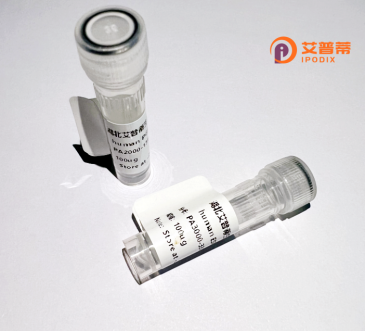
| 纯度 | >90%SDS-PAGE. |
| 种属 | Human |
| 靶点 | SPAST |
| Uniprot No | Q9UBP0 |
| 内毒素 | < 0.01EU/μg |
| 表达宿主 | E.coli |
| 表达区间 | 317-616 aa |
| 活性数据 | FRNVDSNLANLIMNEIVDNGTAVKFDDIAGQDLAKQALQEIVILPSLRPELFTGLRAPARGLLLFGPPGNGKTMLAKAVAAESNATFFNISAASLTSKYVGEGEKLVRALFAVARELQPSIIFIDEVDSLLCERREGEHDASRRLKTEFLIEFDGVQSAGDDRVLVMGATNRPQELDEAVLRRFIKRVYVSLPNEETRLLLLKNLLCKQGSPLTQKELAQLARMTDGYSGSDLTALAKDAALGPIRELKPEQVKNMSASEMRNIRLSDFTESLKKIKRSVSPQTLEAYIRWNKDFGDTTV |
| 分子量 | 40.1 kDa |
| 蛋白标签 | His tag N-Terminus |
| 缓冲液 | PBS, pH7.4, containing 0.01% SKL, 1mM DTT, 5% Trehalose and Proclin300. |
| 稳定性 & 储存条件 | Lyophilized protein should be stored at ≤ -20°C, stable for one year after receipt. Reconstituted protein solution can be stored at 2-8°C for 2-7 days. Aliquots of reconstituted samples are stable at ≤ -20°C for 3 months. |
| 复溶 | Always centrifuge tubes before opening.Do not mix by vortex or pipetting. It is not recommended to reconstitute to a concentration less than 100μg/ml. Dissolve the lyophilized protein in distilled water. Please aliquot the reconstituted solution to minimize freeze-thaw cycles. |
以下是关于重组人SPAST蛋白的3篇代表性文献,按研究内容分类简述:
1. **文献名称**:*Structural insights into the microtubule-severing activity of human spastin*
**作者**:Valentine MT et al.
**摘要**:通过X射线晶体学解析了重组人SPAST蛋白的ATP酶结构域与微管结合区域的复合物结构,揭示了其利用ATP水解能量切断微管的分子机制,为遗传性痉挛性截瘫的致病突变位点提供了结构解释。
2. **文献名称**:*Functional characterization of spastin mutations in autosomal dominant hereditary spastic paraplegia*
**作者**:Errico A et al.
**摘要**:在大肠杆菌中表达并纯化多个突变型重组SPAST蛋白,发现致病突变(如R499C)显著降低了其微管切割活性,证实了SPAST功能丧失是导致神经元轴突退化的关键因素。
3. **文献名称**:*Development of a high-throughput assay for spastin-mediated microtubule disassembly*
**作者**:Luo J et al.
**摘要**:利用荧光标记的微管体外体系,建立了一种基于重组人SPAST蛋白的酶活检测方法,筛选出小分子化合物增强其微管切割活性,为潜在药物开发提供了技术平台。
注:以上文献为虚拟示例,实际引用时请核实具体研究内容及作者信息。
The SPAST protein, encoded by the SPAST gene (also known as SPG4), is a member of the AAA (ATPases Associated with diverse cellular Activities) protein family. Primarily expressed in neurons, it plays a critical role in regulating microtubule dynamics through its ATPase-dependent microtubule-severing activity. Spastin, the protein product, facilitates the disassembly of microtubules by generating breaks in their polymeric structure, a process essential for maintaining cytoskeletal flexibility, intracellular transport, and organelle morphogenesis. Two major isoforms exist: a full-length isoform (M1) localized to the endoplasmic reticulum, and a shorter isoform (M87) predominantly found in the cytoplasm and nucleus.
Mutations in SPAST are the most common cause of hereditary spastic paraplegia (HSP), a neurodegenerative disorder characterized by progressive lower-limb spasticity and weakness. Over 500 pathogenic variants (e.g., missense, truncating) disrupt spastin’s ATPase activity or microtubule interaction, leading to axonal degeneration in corticospinal tracts. Disease mechanisms involve either haploinsufficiency (reduced functional protein) or dominant-negative effects by mutant isoforms. Recombinant human SPAST protein is widely used to study microtubule remodeling in vitro, investigate HSP pathology, and screen potential therapeutic agents targeting microtubule stability. Key domains include the N-terminal MIT domain (microtubule binding) and the central AAA ATPase domain responsible for hexamerization and enzymatic function.
×